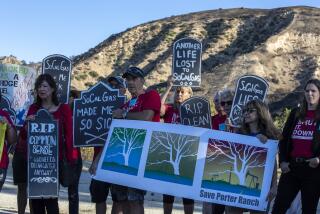Pipe Rupture May Fuel Case for Replacement : Oil: The Valencia break occurred the same day that Mobil released an environmental report warning of a 99.8% chance of such an accident on the aging line.
- Share via
The Friday rupture of a Mobil Oil pipeline in Valencia could improve the company’s chances of obtaining approval to replace the aging line with a modern system, said the lead supervisor of the review process.
The rupture beneath the Valencia Golf Course occurred on the same day that Mobil released a final environmental report on the controversial pipeline proposal. Ironically, the report warns of a 99.8% chance of a rupture along the existing pipeline within five years.
The study also concluded that a new pipeline is the most environmentally sound solution to the woes of the existing system, plagued by eight ruptures in the past five years. The pipeline, which cuts through the Santa Clarita and San Fernando valleys, carries 63,500 barrels a day of heated crude oil from Kern County to a Torrance refinery.
“The spill does give credence to the environmental document,” said Kenneth Cude, division engineer with the Los Angeles Department of Transportation, the lead government agency monitoring the Mobil proposal.
“It should only point toward agencies acting as quickly as possible to allow Mobil to proceed with replacing the pipeline,” Cude added.
Mobil spokesman Jim Carbonetti agreed. Referring to Friday’s oil spill, he said, “this is what we are trying to prevent” with the new pipeline.
A preliminary investigation of Friday’s rupture, which gushed forth more than 63,000 gallons of oil from beneath the golf course driving range and into the Santa Clara River, showed the accident was caused by exterior corrosion of a 20-year-old section of the pipe.
Mobil has been seeking to replace the 75-mile pipeline--some sections of which are 55 years old--after corrosion caused several ruptures. The largest spill occurred Sept. 10, 1988, in Sherman Oaks, when 130,000 gallons of crude oil gushed from a break beneath Ventura Boulevard. That spill prompted state fire officials to voice concern about the pipe’s safety.
The environmental report stated the new high-tech piping system will be better able to monitor for weaknesses and leaks. The proposed system would have more safety valves to automatically shut down the pipe in the event of a rupture. The study concluded that there is a 10.5% chance of rupture and oil spillage over a five-year period with a new pipeline.
Despite promises of improvements, the proposal has been opposed by homeowner group leaders who say that the new pipeline--which would transport 30,000 more barrels of oil a day--will allow Mobil to increase refinery production and create the potential for larger oil spills.
Critics also say the pipeline will create nightmarish traffic and noise problems during its construction.
Don Schultz, president of the Van Nuys Homeowners Assn., said Friday’s rupture does not make him change his mind about opposing the new pipeline. Schultz has said in the past that construction of the pipeline would result in gridlocked traffic.
“If anything, I’m more adamant now that they not go ahead,” Schultz said. “Mobil does not have a handle on how to make it safe. They’ve got such a long history of safety problems, and they should not be given authority for a new line.”
Schultz and other homeowners have said the company’s motive for replacing the pipeline is to pump more oil to its Torrance refinery. “They just want to increase capacity, even though they deny it,” he said.
Department of Transportation commissioners are scheduled to vote Feb. 28 on whether to certify the final environmental impact report. The commission will then decide whether the replacement project can proceed in Los Angeles. Other jurisdictions through which the pipeline would pass, such as the city of Santa Clarita and the U.S. Forest Service, also must approve the project before it could proceed.
Times staff writer Greg Braxton contributed to this report.
Oil Pipeline Rupture and Spill Pipeline Rupture: At least 63,000 gallons of crude oil spill into the Santa Clara River and travel about 8 miles. Site of Pipeline Rupture Past Oil Spills 1. Lebec, June, 1987: 105,000 gallons crude oil 2. Valencia, July 22, 1988: 300 gallons crude oil 3. Granada Hills, April 6, 1986: 29,000 gallons crude oil 4. Granada Hills, June 23, 1990: 67,000 gallons oil-tainted water 5. Sherman Oaks, Sept. 10, 1988: 130,000 gallons crude oil 6. Sherman Oaks, Sept. 27, 1988: 125,000 gallons oil-tainted water 7. Torrance, June 1986: 6,300 gallons crude oil
More to Read
Sign up for Essential California
The most important California stories and recommendations in your inbox every morning.
You may occasionally receive promotional content from the Los Angeles Times.










